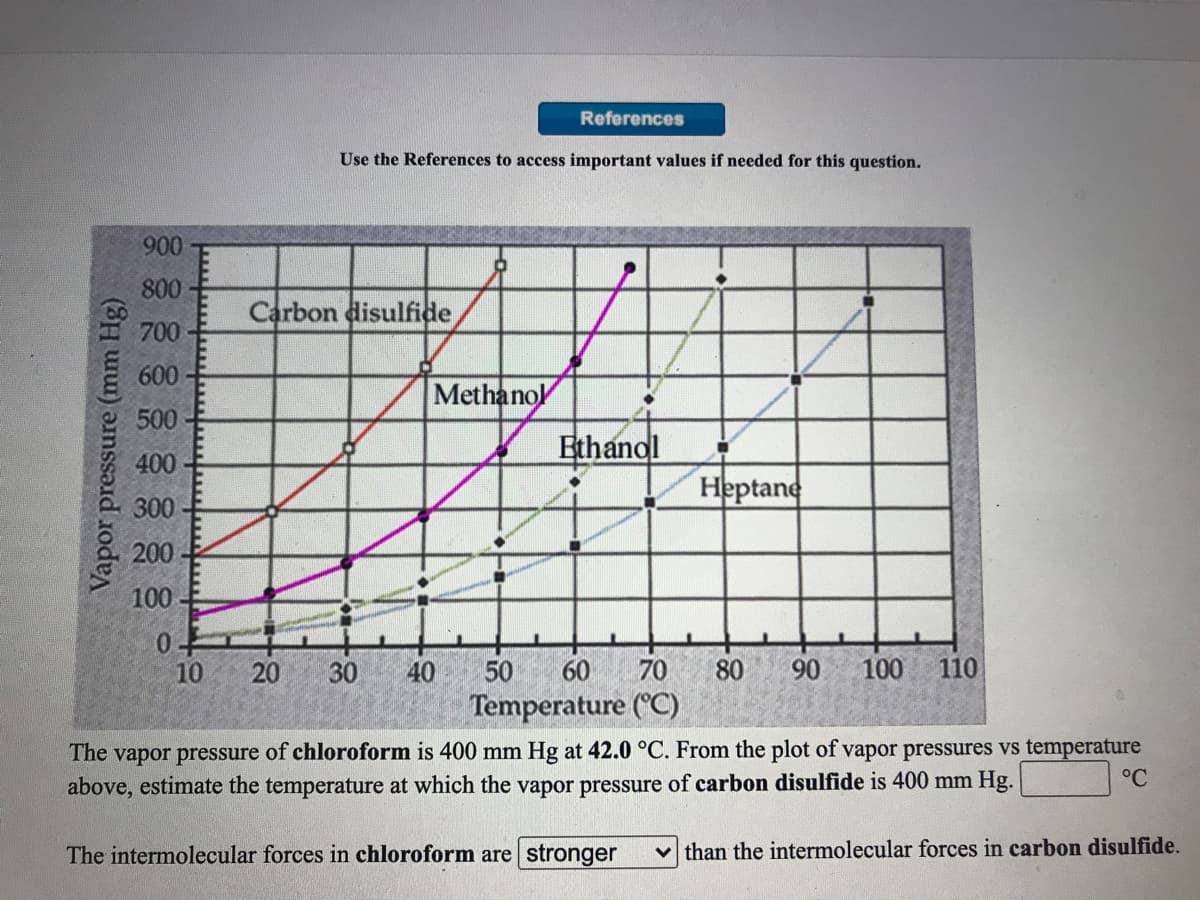900 800 Carbon disulfide 700 600 Methano 500 Ethanol 400 Heptane 300 200 100 0. 10 20 30 40 50 60 70 80 90 100 110 Temperature (°C) The vapor pressure of chloroform is 400 mm Hg at 42.0 °C. From the plot of vapor pressures vs temperature above, estimate the temperature at which the vapor pressure of carbon disulfide is 400 mm Hg. °C The intermolecular forces in chloroform are | stronger v than the intermolecular forces in carbon disulfide. Vapor pressure (mm Hg)
900 800 Carbon disulfide 700 600 Methano 500 Ethanol 400 Heptane 300 200 100 0. 10 20 30 40 50 60 70 80 90 100 110 Temperature (°C) The vapor pressure of chloroform is 400 mm Hg at 42.0 °C. From the plot of vapor pressures vs temperature above, estimate the temperature at which the vapor pressure of carbon disulfide is 400 mm Hg. °C The intermolecular forces in chloroform are | stronger v than the intermolecular forces in carbon disulfide. Vapor pressure (mm Hg)
Chemistry: Principles and Practice
3rd Edition
ISBN:9780534420123
Author:Daniel L. Reger, Scott R. Goode, David W. Ball, Edward Mercer
Publisher:Daniel L. Reger, Scott R. Goode, David W. Ball, Edward Mercer
Chapter11: Liquids And Solids
Section: Chapter Questions
Problem 11.95QE: A 1.50-g sample of methanol (CH3OH) is placed in an evacuated 1.00-L container at 30 C. (a)...
Related questions
Question

Transcribed Image Text:References
Use the References to access important values if needed for this question.
900
800
Carbon disulfide
700
600
Methanol
500
Ethanol
400
Heptane
300
200
100-
0.
10
20
30
40
50
60
70
80
90
100
110
Temperature (°C)
The vapor pressure of chloroform is 400 mm Hg at 42.0 °C. From the plot of vapor pressures vs temperature
above, estimate the temperature at which the vapor pressure of carbon disulfide is 400 mm Hg.
°C
The intermolecular forces in chloroform are stronger
than the intermolecular forces in carbon disulfide.
Vapor pressure (mm Hg)
Expert Solution
This question has been solved!
Explore an expertly crafted, step-by-step solution for a thorough understanding of key concepts.
This is a popular solution!
Trending now
This is a popular solution!
Step by step
Solved in 2 steps with 1 images

Knowledge Booster
Learn more about
Need a deep-dive on the concept behind this application? Look no further. Learn more about this topic, chemistry and related others by exploring similar questions and additional content below.Recommended textbooks for you

Chemistry: Principles and Practice
Chemistry
ISBN:
9780534420123
Author:
Daniel L. Reger, Scott R. Goode, David W. Ball, Edward Mercer
Publisher:
Cengage Learning

Chemistry & Chemical Reactivity
Chemistry
ISBN:
9781337399074
Author:
John C. Kotz, Paul M. Treichel, John Townsend, David Treichel
Publisher:
Cengage Learning

Chemistry & Chemical Reactivity
Chemistry
ISBN:
9781133949640
Author:
John C. Kotz, Paul M. Treichel, John Townsend, David Treichel
Publisher:
Cengage Learning

Chemistry: Principles and Practice
Chemistry
ISBN:
9780534420123
Author:
Daniel L. Reger, Scott R. Goode, David W. Ball, Edward Mercer
Publisher:
Cengage Learning

Chemistry & Chemical Reactivity
Chemistry
ISBN:
9781337399074
Author:
John C. Kotz, Paul M. Treichel, John Townsend, David Treichel
Publisher:
Cengage Learning

Chemistry & Chemical Reactivity
Chemistry
ISBN:
9781133949640
Author:
John C. Kotz, Paul M. Treichel, John Townsend, David Treichel
Publisher:
Cengage Learning

World of Chemistry, 3rd edition
Chemistry
ISBN:
9781133109655
Author:
Steven S. Zumdahl, Susan L. Zumdahl, Donald J. DeCoste
Publisher:
Brooks / Cole / Cengage Learning


Introductory Chemistry: A Foundation
Chemistry
ISBN:
9781337399425
Author:
Steven S. Zumdahl, Donald J. DeCoste
Publisher:
Cengage Learning